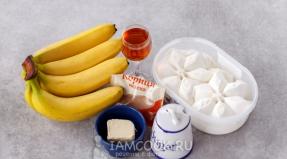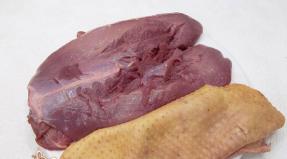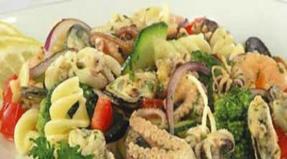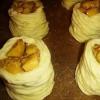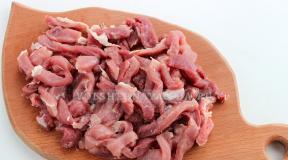Methods for the production of fermented milk drinks. Technology for the production of fermented milk products of liquid and semi-liquid consistency
In accordance with GOST R 52090-2003 “Drinking milk. Specifications» drinking milk subdivided depending on the raw milk used: from natural milk, from normalized milk, from reconstituted milk, from recombined milk, from their mixtures; depending on the heat treatment mode: pasteurized, melted, sterilized, UHT (ultra high temperature)-treated, UHT-treated sterilized; according to fat content: low fat (0.1%), low fat (0.3; 0.5; 1.0% fat), low fat (1.2; 1.5; 2.0; 2.5% fat), classic (2, 7; 3.0; 3.2; 3.5; 4.0; 4.5% fat), fatty (4.7; 5.0; 5.5; 6.0; 6.5; 7.0 % fat), high fat (7.2; 7.5; 8.0; 8.5; 9.0; 9.5% fat).
Pasteurized milk. Milk subjected to heat treatment under certain temperature conditions (up to 100 0 C) and then chilled. The technological process for the production of drinking milk at the factories is carried out according to the scheme: cleaning, normalization, homogenization, cooling, bottling with packaging and storage.
Milk homogenization(homogeneous - homogeneous). In the process of homogenization, large fat globules are crushed and uniform in size are obtained with an average diameter of about 1 micron. From one fat ball with a diameter of 6 microns, more than 200 small ones, with a diameter of 1 micron, are formed. In homogenized milk, there is practically no settling of cream.
sterilized milk. The production of sterilized milk at factories can be carried out according to two schemes: with one-stage and two-stage sterilization mode. With a single-stage scheme, milk is sterilized once before or after packaging at a temperature of 130-150 0 C with a holding time of 2-3 s. This mode is accompanied by the least changes in the native properties of milk. Such milk can be stored for up to 2 months from the date of release from the factory at a temperature of 1 to 20 0 C. In a two-stage mode, milk is sterilized with an exposure for 20 seconds, and then in bottles with steam at a temperature of 116-118 0 C for 12-15 min. Double sterilization causes deeper changes in the constituents of milk, but at the same time ensures its high stability - it can be stored in unrefrigerated rooms for more than a year.
Reconstituted milk is produced by complete or partial dissolution of dry whole or skimmed milk in drinking water at a temperature of 38-42 0 C, followed by its purification, homogenization and normalization by fat.
protein milk contains an increased amount of dry skimmed milk residue. It is produced from milk, normalized in terms of fat content, with the addition of dry or condensed whole or skimmed milk.
Baked milk- a specific product with certain taste properties and a pronounced color shade. It is produced from normalized and homogenized ordinary milk, which is heated to a temperature of 96-98 0 C and kept at this temperature for 3-4 hours. As a result of prolonged exposure to high temperatures, physical and chemical changes in milk proteins and lactose occur, so the finished product has a pronounced taste boiled milk and acquires a cream color with a brown tint.
Dairy products produced by fermentation of milk and cream with pure cultures of lactic acid bacteria (sourdough). Most of the fermented milk products have not only high nutritional, dietary, but also medicinal properties. Acidophilus bacilli, as well as yeast used in the production of fermented milk products, are capable of secreting significant amounts of antibiotics such as nisin, lactolin, lactomine, etc. Scientifically based human nutrition standards provide that 40-50% of all milk intended for consumption, it is desirable to use in the form of fermented milk products, which are absorbed by the body much easier and faster than milk.
Producing dairy products:
1) liquid and semi-liquid consistency (yogurt, kefir, etc.);
2) high in fat (sour cream);
3) with a high protein content (cottage cheese, curd mass, curd products).
Depending on the type of fermentation, fermented milk products are distinguished, obtained only using lactic acid fermentation and accumulation of lactic acid (curdled milk of all kinds, yogurt, acidophilus and acidophilus milk, the Snezhok drink, and products obtained by joint lactic acid and alcoholic fermentation, when lactic acid, ethyl alcohol and carbon dioxide accumulate (kefir, koumiss, acidophilic yeast milk, etc.). In the manufacture of fermented milk products, starters are used, which are prepared on pure cultures of the corresponding types of microorganisms. In the process of fermentation, biochemical and physico-chemical changes occur in almost all components of milk.
The use of lactic acid microorganisms in various combinations makes it possible to obtain a large number of types of fermented milk products. The dairy industry produces various fermented milk products: yogurt of all kinds, yogurt, kefir, acidophilic products, koumiss, sour cream, cottage cheese, etc.
The production of fermented milk products consists of the following processes: receiving and sorting milk, normalization, pasteurization, homogenization, cooling, fermentation, fermentation, cooling, maturation, storage, sale.
Liquid fermented milk products are prepared by thermostatic and reservoir methods. The thermostatic and reservoir methods have the same initial technological operations, including fermentation.
thermostatic method the production of sour-milk drinks is a method in which the fermentation of milk and the maturation of drinks is carried out in bottles in thermostatic and cold chambers.
tank method production of liquid sour-milk drinks - a method in which fermentation, fermentation of milk and maturation of drinks is carried out in one container.
Butter and cheese making
Butter - high-calorie food product, which is a concentrate of milk fat. The raw material for the preparation of butter is cream, which is subjected to the process of whipping. It consists mainly of a fatty part and water. The quality of butter and its stability during long-term storage largely depend on the quality of milk and cream. Particular attention should be paid to the defects of milk fat, as they increase in butter (20-25 kg of milk is used to produce 1 kg of butter). The best is milk with a high fat content, which has large fat globules, obtained from cows whose diets were complete in terms of general nutrition, protein, and minerals. With an increase in the fat content of milk, its costs for the production of butter decrease and relatively less fat remains in by-products - skimmed milk and buttermilk.
There are two ways to produce butter:
1) churning cream;
2) conversion of high-fat cream.
Cream churning method provides for the production of butter grain from cream of medium fat content (30-35%) and its subsequent mechanical processing. Oil by this method can be produced in butter makers of periodic action (roller and rollerless) and continuous action.
Process for converting high fat cream(82% fat or more) consists in thermomechanical action on high-fat cream in special devices.
Carrying out separate operations when obtaining butter by the method of churning cream. Cream normalization. For sweet cream butter, the optimal fat content of cream is 32-37%.
Pasteurization. Normalized cream of the I grade is pasteurized at a temperature of 85-90 0 C without aging, of the II grade - at 92-95 0 C, to destroy the microflora and the lipase enzyme.
Cooling and physical ripening of cream. After pasteurization, the cream is quickly cooled to 4-6 0 C. At this temperature (physical maturation), mass crystallization of milk fat glycerides occurs: it passes from a liquid state to a solid state, which makes it possible to form an oil grain during subsequent churning.
At physical maturation the fat globules become more elastic, their protein shell thins out, the viscosity of the cream increases, and the fat globules are able to form lumps to a greater extent. The lower the temperature, the shorter the ripening time of the cream. With deep cooling (0-1 0 C) and intensive mixing, the ripening period of cream is reduced to several minutes, which makes it possible to create in-line technological lines for butter production.
Biochemical maturation used in the manufacture of sour cream butter. Its essence lies in the fermentation of cream with starters (the same as in the preparation of sour cream). Biochemical maturation contributes to a greater thinning of the shell of fat globules and the release of fat from them.
Filling the oil maker. The buttermaker is filled with cream by about 35-40% of the volume. The temperature of the cream in the spring-summer period should be 7-12 0 C, in the autumn-winter period 8-14 0 C.
Whipping cream. When cream is churned into butter, the shell of fat globules is destroyed and they are combined into a butter grain. At the heart of the process of churning butter is the flotation theory, which consists in the fact that when churning cream, air bubbles (foam) are formed. Fat globules accumulate (float) on the surface of the air bubbles. Under the action of mechanical shocks, the air bubbles burst and the fat globules are interconnected by bare areas into conglomerates.
Removal of buttermilk and washing of butter grains. When the grains are ready, the buttermilk is removed by filtering it through a sieve in order to retain small grains. Then the grains (oil) are washed 2 times. Waters take 50-60% of the amount of cream. The temperature of the first washing water is equal to the temperature of the cream, the second is lower by 1-2 0 C. In the manufacture of sour cream butter, it is washed less intensively, using only 15-20% of water by weight of the cream, to preserve the specific taste and smell.
Oil processing. The goal is to combine the oil grain and obtain a layer of a uniform consistency, give the oil a certain structure, marketable appearance, evenly distribute salt and moisture throughout the mass, and disperse water drops to a minimum size. Processing is carried out by passing oil between the rollers of the oil maker. Its rotation speed is 3-5 rpm. The duration of treatment in summer is 20-30 minutes, in winter 30-50 minutes. In the finished oil, on the cut and on the surface, there should be no noticeable drops of moisture.
Butter production by converting high-fat cream. This method allows you to create in-line production. Its essence lies in the fact that first milk is separated on a conventional separator, cream with a 35-40% fat content is obtained, then they are pasteurized at a temperature of 85-90 0 C. Pasteurized cream is separated at a high temperature on a special separator in order to obtain high-fat cream (84- 85%), normalize them to the required fat content and send them to the oil former, where they are cooled and turned into oil.
Oil classification. In accordance with the requirements of the standard, butter is divided into the following types: unsalted, salted, Vologda, amateur, peasant, melted, etc.
unsalted and salty butter is made from pasteurized cream with or without the use of pure cultures of lactic acid bacteria (sweet cream or sour cream). When making salted butter, table salt is added.
Vologda unsalted butter is made from sweet cream that has been pasteurized at high temperatures and has a nutty taste and smell.
amateur butter is made from pasteurized cream with or without the use of pure cultures of starter cultures (sweet cream or sour cream), with or without the addition of table salt (salted or unsalted).
Peasant butter unsalted butter is produced from pasteurized cream with or without the use of pure cultures of lactic acid bacteria (sweet cream or sour cream), and peasant sweet cream salted from fresh pasteurized cream.
Ghee Butter is rendered milk fat with its specific taste and aroma. Each type of oil is characterized by a certain chemical composition.
When determining the quality of the oil, its chemical composition and organoleptic evaluation data are taken into account, which is performed on a 100-point scale. The results of the assessment for taste, smell, consistency, color, salting, packaging and labeling are summarized and the grade of oil is determined by the total score: the highest (more than 88 points) and the first (more than 80 points).
Cheese making. Cheese- a highly valuable food product obtained from milk by enzymatic coagulation of proteins, isolation of cheese mass, followed by its processing and maturation. According to the International Dairy Federation, more than 500 types of cheeses are produced in countries with developed dairy farming that are members of the federation.
classify cheeses on a number of grounds, primarily on the features of technologies. Cheeses are divided mainly into rennet and sour-milk. Processed or processed cheeses are also produced.
Each type of cheese is characterized by a certain shape, organoleptic properties, chemical composition, which must comply with the standard.
Cheese technology consists of a number of operations that can be performed differently, which determines the characteristics of a particular type of cheese or a group of cheeses. In general, the process of production of natural rennet cheeses is carried out according to the following scheme: 1) Determination of the quality of milk and its sorting; 2) Preparation of milk for processing; 3) Coagulation of milk; 4) Processing curd and curd; 5) Cheese molding; 6) salting cheese; 7) Cheese maturation; 8) Preparation of cheese for sale; 9) Storage and transportation.
Requirements for milk for the production of cheese. Milk with defects in organoleptic characteristics is unsuitable for cheese production. In the finished cheese, the defects of taste and smell are more pronounced than in milk. The yield of cheese depends on the content of fat and casein in milk. For the production of cheese, milk is used only 7-10 days after calving and 7-10 days before the start of cows, since the admixture of colostrum or old-fashioned milk with normal milk reduces the quality of the cheese. The milk of cows suffering from mastitis is unsuitable for cheese making. Milk should contain a sufficient amount of calcium and phosphorus, especially calcium, which is in a soluble state. For cheese making, milk with an acidity of not more than 20 0 T is used, since high-quality cheese cannot be obtained from milk with high acidity.
Cheese suitability of milk is estimated by the duration of its coagulation by rennet. Milk that coagulates slowly under the action of rennet is considered non-chewy or rennet. To improve cheese suitability, calcium chloride, an increased dose of bacterial starter are added to milk, and the temperature of milk clotting is also increased. So-called "mature" milk is used to make cheese. Freshly milked milk cannot be processed into cheese, as it does not coagulate well with rennet. Exposure (ripening) of high-quality milk for 10-15 hours at 8-10 0 C leads to the development and accumulation of lactic acid microflora, enlargement of casein micelles, and an increase in acidity by 1-2°T. The changes that take place (ripening) have a positive effect on the quality of the cheese.
Pasteurization. In cheesemaking, pasteurization of milk is used at 71-72 0 C, higher temperatures of pasteurization lead to the loss of the milk's ability to coagulate.
Curdling of milk. To coagulate milk, an enzyme preparation is used - rennet powder, obtained at special factories from the mucous membrane of the abomasum of suckling calf lambs. Pepsin, obtained from the gastric mucosa of adult animals, is also used to coagulate milk. Before curdling, bacterial starter, calcium chloride, chemically pure potassium or sodium nitrate (to suppress the development of Escherichia coli), and paint are added to cooled milk. After that, the required amount of rennet is set to coagulate the milk.
Clot processing. The curd treatment is carried out in order to partially remove whey from the curd and cheese grain, as well as to create optimal conditions for microbiological and biochemical processes in the curd, grain and cheese in the first period of its ripening. To speed up and more complete release of whey, the clot is subjected to cutting, kneading the resulting cheese grain, and second heating. The clot is cut with the help of cheese lira and knives. Cutting the clot and grinding it to the required size is called setting the curd.
Plastovanie cheese grain- carried out in order to connect the cheese grain into a continuous monolith.
Cheese molding. To give the cheese an appropriate shape characteristic of a particular type, the cheese mass is molded. To do this, the cheese layer is cut into pieces corresponding to the forms (45x10 cm) and laid in these forms.
Cheese pressing. Cheeses are pressed to give them shape, firmness and to remove whey residue. The duration of pressing is 2-3 hours at a press pressure of 30-40 kg per 1 kg of cheese mass, the air temperature should be 15-18°C.
Cheese salt. Salting gives the cheese certain taste qualities, with the help of salting the development of microbiological processes is regulated, it affects the changes in the physico-chemical properties of the cheese rind, cheese dough and the yield of cheese.
Cheese maturation. This is a complex of sequential complex biochemical changes in the substances of the cheese mass. Ripening gives the cheese pronounced organoleptic properties characteristic of this type, primarily taste and smell, as well as color, texture, pattern, which distinguish mature cheese from fresh cheese mass. The duration of ripening is up to 2.5 months or more (depending on the type of cheese).
Waxing and packaging of cheese. Ripened cheeses are thoroughly washed, rinsed in a lime solution, dried, factory stamped and waxed to prevent shrinkage during their long-term storage. Some types of polymer films are also used to protect cheese from shrinkage and the development of aerobic microflora on the surface of the cheese head.
Storage and transportation of hard cheese. During transportation, cheeses must be protected from high and extremely low temperatures. They do not undergo changes at temperatures from plus 10 to minus 6 0 C. If cheeses are transported at high temperatures, the cheese dough softens, fat is released, resulting in a deterioration in taste and texture. When cheese freezes after thawing, it becomes crumbly, and its taste is empty, unexpressed. In refrigerators for long-term storage of cheese, the air temperature should be from 0 to 2 ° C, for short-term storage - 2-8 0 C. Hard rennet cheeses are stored for up to 8 months, soft - up to 4 months, Swiss - up to a year or more. Each type of finished cheese is characterized by a certain shape, chemical composition, organoleptic properties. The organoleptic evaluation of hard cheese is made on a 100-point scale. Depending on the overall assessment and assessment for taste and smell, the cheese is classified as the highest (more than 87 points) and the first (more than 75 points) grade. Cheeses that do not meet the requirements of the standard in composition or have received a score of less than 75 points are subject to processing into processed cheeses.
Processed cheese production. Both non-standard cheeses and cheeses of various degrees of maturity and grade are used as feedstock. In addition, "specific" processed cheeses are produced from natural high-quality cheeses of the same type. These cheeses are named after the cheese from which they are made (processed Kostroma, Russian processed, etc.).
The technological scheme for the production of processed cheese includes the following operations: 1) selection, cleaning and grinding of cheese; 2) preparation of a mixture for melting and the introduction of melting salts; 3) maturation of the mixture; 4) cheese melting; 5) packaging; 6) Processed cheese cooling and storage.
An important process in the production of processed cheeses is the addition of melting salts (dibasic sodium phosphate, sodium metaphosphate, tartaric salt, etc.) to the crushed cheese mass. The introduction of melting salts into the cheese mass significantly reduces the release of moisture from the cheese mass when it is melted (heated to 95 ° C), the mass turns out to be plastic, viscous, with increased swelling. Upon cooling, a gel is formed, the properties of which largely depend on the selection of the melting salt.
Processed cheeses are packaged in the molten state in aluminum foil, plastic molds. The shelf life of processed cheeses is 3-6 months at 5-8 0 C. The assortment of processed cheeses is the most diverse. They produce smoked processed cheese, sterilized processed cheese, pasteurized processed cheese, sweet processed cheeses, plastic (chocolate, coffee, with fruits, with nuts) cheeses, powdered processed cheeses, etc.
32 33 34 35 36 37 38 39 ..General technology of dietary fermented milk products
Common in the production of all fermented milk drinks is the fermentation of prepared milk with starters and, if necessary, maturation. The specifics of the production of individual products differ only in the temperature regimes of some operations, the use of starters of different composition and the introduction of fillers.
For a long time, all fermented milk drinks were produced by the thermostatic method, in which fermented milk is poured into small containers and fermented at temperatures that are optimal for each product in a thermostatic chamber. After the formation of a clot, the product is sent to the refrigerator, where it is cooled and, if necessary, kept for some time to mature.
In accordance with the reservoir method (M. G. Demurov), the fermentation and maturation of the product is carried out in tanks with stirring. This reduces production space and labor costs.
For the production of dietary fermented milk drinks, milk is used not lower than the second grade, with an acidity not higher than 19 °T, and cream - with a plasma acidity not higher than 24 °T.
Normalized milk is pasteurized at temperatures of 85-87 °C with a holding time of 5-10 minutes or 90-92 °C with a holding time of 2-3 seconds to more completely destroy the microflora, destroy enzymes, activate the development of the starter microflora, and improve the consistency of the product. Under these conditions, denaturation of whey proteins occurs, as a result of which the hydration properties of casein increase and its ability to form a denser clot that retains well
serum. This is facilitated by the participation of denatured whey proteins in the formation of the milk clot structure.
Heat treatment is usually combined with milk homogenization at a temperature of 60-70 ° C and a pressure of 12.5-17.5 MPa, which provides a more uniform and dense consistency, and in a stirred state - more viscous, prevents cream settling with better whey retention. In the production of fermented milk drinks, homogenization is essential, since cream sedimentation is inevitable during long fermentation and cooling processes.
The milk is then cooled to the optimum fermentation temperature and the starter is immediately introduced into it to prevent the development of extraneous microflora. The sourdough is usually introduced into the mixer using a dispenser.
In the production of fermented milk products, lactic acid streptococci are used: mesophilic (Lc. lactis) with an optimal development temperature of 30-35 ° C and thermophilic (Str. termophilus) with an optimal development temperature of 40-45 ° C.
To give the clot a creamy consistency, creamy streptococcus (Lc. cremoris) is introduced into the starter, the optimum development temperature of which is 30 ° C. Some starter cultures contain aroma-forming streptococci (Str. citrovorus, Str. paracitrovorus, Lc. diacetilactis, Lc. lactis subsp. acetoinicus, Lc. lactis subsp. diacetilactisf. enterococci. In the course of their life, in addition to lactic acid, they form volatile acids, carbon dioxide, alcohols, ethers, diacetyl, giving the product a specific smell, giving certain properties of consistency.These microorganisms are capable of biosynthesis of vitamins, amino acids, carbon-containing polymers.
A combination of starter cultures gives certain qualities to a fermented milk product. The optimum temperature for their development is 25-30 °C. Microorganisms can increase the acidity in the drink up to 80-120 °T.
Lactic acid sticks are stronger acid formers. Of these, the Bulgarian bacillus (L. bulgaricum) and acidophilic (L. acidophilum) are widely used in the production of starter cultures, etc. with an optimal development temperature of 40-45 ° C and a limiting acidity of milk fermentation up to 200-300 ° T.
The starter composition of some fermented milk drinks includes lactic yeast, which provides alcoholic fermentation, as a result of which the drinks acquire a slightly spicy, stinging taste and foamy texture.
The quality of fermented milk drinks largely depends on the quality of the starter used. It should have a dense homogeneous clot, a pleasant taste and smell, optimal acidity (streptococcal - not higher than 80 °T, rod-shaped - not higher than 100 °T). With increased acidity, the activity of the starter decreases, which increases the duration of milk coagulation and worsens the quality of the finished product. The leaven is added depending on its activity in an amount of 1 to 5%.
Milk is fermented at the fermentation temperature until a tender, fairly dense clot is formed, with no signs of whey separation, and to an acidity slightly lower than in the finished product.
After fermentation, the product is immediately cooled. With the thermostatic method, it is sent to the refrigerator, where it is cooled to a temperature of 6-8 ° C. Care must be taken when handling the product to avoid disturbing the delicate clot. The clot obtained by the reservoir method is cooled with light stirring in the same container by supplying ice water to the reservoir jacket. In this case, the properties of the formed clot change somewhat.
The lactic acid process weakens with decreasing temperature, proceeds slowly, and the optimal acidity for this type of product is gradually achieved, and at 8-10 ° C, acid formation practically stops. There is also swelling of the proteins, which leads to the binding and reduction of free moisture and compaction of the clot.
Products of mixed fermentation (kefir, koumiss, acidophilic yeast milk) after cooling are subjected to maturation in refrigerators (with a thermostatic method) or tanks. At the same time, the lactic acid process fades, yeast is activated in an acidic environment, alcoholic fermentation occurs with the accumulation of alcohol, carbon dioxide, etc., which give these drinks specific properties. The maturation of the product in tanks lasts, depending on the type of product, from 12 hours to 3 days at a temperature of 8-10 °C. After maturation, it is bottled and sent for storage in refrigerators.
In order to make better use of production space in some countries (Bulgaria, Hungary, etc.), fermentation and cooling of fermented milk drinks are carried out in one chamber by changing the air temperature in it.
Storage before sale of dietary fermented milk drinks is carried out in refrigerators at a temperature of 0 to 6 ° C and a humidity of 85-90% under strict sanitary and hygienic conditions. They are released from enterprises at a temperature not exceeding 8 ° C after checking the physico-chemical and organoleptic parameters of each batch of the product.
Fermented milk products are produced by thermostatic and reservoir methods. (Tverdokhleb G.V., 1991)
reservoir method. The technological process for the production of beverages by the reservoir method consists of the following technological operations: acceptance and preparation of raw materials, quality assessment, normalization, homogenization, pasteurization and cooling, fermentation, fermentation in special containers, curd cooling, curd maturation (kefir, koumiss), packaging.
For the production of fermented milk drinks, milk is used not lower than the second grade, with an acidity of not more than 19 °T, and a density of at least 1027 kg / m 3. Powdered milk is pre-reconstituted. Skimmed milk, buttermilk, cream, condensed and powdered milk, sodium caseinate, fruit and berry and vegetable fillers must be of good quality, without foreign tastes and odors and defects in texture.
Sour-milk drinks are produced with different mass fractions of fat, so the original milk is normalized to the required mass fraction of fat. Normalization of milk is carried out in a stream on separators-normalizers or by mixing. Some products are made from skimmed milk. When normalizing raw materials by mixing, the mass of products for mixing is calculated according to the formulas of the material balance or determined according to the recipe.
The scheme of the technological line for the production of fermented milk drinks by the tank method is shown in Figure 1.
Rice. one. 1 -- installation for dissolving milk powder; 2 -- container for the normalized mixture; 3 -- centrifugal pump; 4 - balancing tank; 5 - pasteurization and cooling unit; 6-- centrifugal milk cleaner; 7 - homogenizer; 8-- holder; 9, 14 -- containers for fermented milk drinks; 10-- starter; 11 -- dosing pump; 12 -- screw pump; 13-- plate cooler. (Bredikhin S.A., 2001)
The normalized mixture is subjected to heat treatment. As a result of pasteurization, microorganisms in milk are destroyed and conditions favorable for the development of the starter microflora are created. The normalized mixture is pasteurized at a temperature of 92 ± 2 ° C with an exposure of 2 ... 8 minutes or at a temperature of 85 ... 87 ° C with an exposure of 10 ... 15 minutes; UVT treatment is possible at 102 ± 2 °C without exposure. For the production of fermented baked milk, the mixture is pasteurized at 95...98 °C with an exposure of 2...3 hours. High pasteurization temperatures cause denaturation of whey proteins, while increasing the hydration properties of casein. This contributes to the formation of a denser clot that retains moisture well, which, in turn, prevents the separation of whey during storage of fermented milk drinks.
The heat treatment of the mixture is usually combined with homogenization at a temperature of 60...65 o C and a pressure of 15...17.5 MPa.
After pasteurization and homogenization, the mixture is cooled to the fermentation temperature, after which it enters the fermentation tank. Starter is added to the cooled mixture, the mass of which is usually 5% mass of fermented mixture. Direct fermentation is used.
The fermentation of the mixture is carried out at the fermentation temperature. During fermentation, the ferment microflora multiplies, acidity increases, casein coagulates and a clot is formed. The end of fermentation is judged by the formation of a sufficiently dense clot and the achievement of a certain acidity.
After fermentation, the product is immediately cooled.
Kefir, produced with ripening, after fermentation is cooled to 14...16 °C and ripens at this temperature. The duration of maturation of kefir is at least 10 ... 12 hours. During maturation, yeast is activated, alcoholic fermentation occurs, as a result of which alcohol, carbon dioxide and other substances are formed in the product, giving this product specific properties. In the production of fruit kefir, fillers are added after maturation before packaging.
Sour-milk drinks are packaged in heat-sealed bags, boxes, cups, etc.
thermostatic method. The technological process for the production of fermented milk drinks by the thermostatic method consists of the same technological operations as in the production of the tank method, carried out in the following sequence: preparation of raw materials, normalization, pasteurization, homogenization, cooling to the fermentation temperature, fermentation, packaging, fermentation in thermostatic chambers, cooling clot, clot maturation (kefir, koumiss).
The scheme of the technological line for the production of fermented milk drinks by the thermostatic method is shown in Figure 2.

Rice. 2. 1 -- container for raw milk; 2 -- pump; 3 -- balancing tank; 4 - pasteurization and cooling plant; 5 - control panel; 6-- return valve; 7 - separator-normalizer; 8 -- homogenizer; 9 -- container for keeping milk; 10-- container for fermenting milk; 11 - car for packing milk; 12 -- thermostatic chamber; 13 -- refrigerating chamber; 14 -- storage room for finished products. (Bredikhin S.A., 2001)
Acceptance and preparation of raw materials, normalization, heat treatment, homogenization of the normalized mixture and its cooling to the fermentation temperature are performed in the same way as in the tank production method. Next, the normalized mixture is fermented in a container. After fermentation, the mixture is packaged in consumer containers and sent to a thermostatic chamber, where a temperature is maintained that is favorable for the development of the microflora of the starter. The end of fermentation is judged by the acidity and density of the clot. After fermentation is completed, the product is sent to the refrigerator for cooling, and kefir for maturation.
The tank method for the production of fermented milk drinks has a number of advantages compared to the thermostatic method. Firstly, this method makes it possible to reduce production areas by eliminating bulky thermostatic chambers. At the same time, the removal of products from 1 m 2 of the production area increases and the consumption of heat and cold decreases. Secondly, it allows for a more complete mechanization and automation of the technological process, reducing manual labor costs by 25% and increasing labor productivity by 35%.
Defects of dairy products
Defects in fermented milk products arise as a result of the use of low-quality raw materials, the action of bacterial starter cultures in violation of the technological regimes of production or non-compliance with the conditions of cooling and storage of finished products.
Defects of taste and smell. Unexpressed (fresh) taste - is caused by low acidity, weak aroma and insufficient density of the clot. Such a defect appears when using low-quality starter (poor acid formation) or at too low fermentation temperatures.
Feed flavors that have passed from milk to fermented milk products (wormwood, silage). Ammonia and bready flavors appear when milk is kept in a poorly ventilated barn for a long time.
A bitter taste may appear as a result of the development of peptonizing bacteria in the case of long-term (up to two days) storage of raw milk at low temperatures, as well as in cottage cheese when excessive doses of pepsin are added.
A metallic taste appears in products when they are stored for a long time in poorly tinned dishes.
Excessively sour taste is detected as a result of delayed cooling after ripening or due to a long time of fermentation itself, as well as during storage at unacceptably high temperatures.
Acetic acid and butyric taste depend on the activity of the corresponding extraneous microflora that has entered milk or sourdough.
A greasy taste in sour cream may appear as a result of oxidative processes of fat during long-term storage or direct sunlight on the surface of sour cream. (Kastornykh M.S., 2003)
Consistency defects
A flabby clot is the result of using starter cultures with weakened cultures or aging the product at low temperatures, as well as violations of the pasteurization temperature regime (at low temperatures and without aging).
A viscous consistency is formed with a significant predominance of mucous races of lactic acid bacteria in the leaven.
The isolation of whey - the main defect of fermented milk products produced by the tank method - is a consequence of the unsatisfactory quality of raw materials (low solids content), deviations from the normal mode of homogenization and pasteurization of milk during the fermentation of the product.
The swollen consistency is caused by infection of the starter with gas-forming bacteria, and also appears at low fermentation temperatures. (Shepelev A.F., 2001)
The production of sour-milk dietary products - kefir, acidophilus, acidophilus milk, acidophilus-yeast milk, Snezhok, Yuzhny, yogurt and others - has increased tenfold.
Kefir is the most popular among the population, so it has taken a dominant position in the production of fermented milk drinks produced in Russia.
The birthplace of kefir is the North Caucasus, where for a long time it was made in wineskins or in wooden tubs. The technology of its production in the villages is simple - kefir fungi are poured with fresh milk cooled to 18-20 "C, during the ripening and maturation process, the product is periodically shaken. When kefir ripens, due to increased aeration, yeast actively develops, which affects the taste and consistency of the product: the consistency becomes liquid, creamy, taste-specific, sour, becomes sharp.
In Russia, kefir was produced as early as 1866-1867. in an artisanal way on fungi brought from the Caucasus in a dry form. Kefir fungi were revived in boiled chilled skim milk and used to make starter cultures. Milk for kefir was heated up to 16-23°C and fermented with starter directly drained from fungi. After obtaining a clot, the bottles were shaken to speed up the process of forming a drink and kept indoors at a temperature of 14-16 ° C for a day, and sometimes for a longer time.
The same technology was used to produce kefir at city dairies, while pasteurization of milk and bottling of the drink into bottles with hermetic seals were used. As a result of the length of the technological process, the laboriousness of many operations, the production of kefir was limited and the demand from the population for it was not satisfied, so the technology of kefir was changed: they began to produce it, in an accelerated way, which later received the name thermostatic.
Milk used for the production of kefir began to be fermented at high temperatures in thermostats without shaking and the corresponding accumulation of yeast fermentation products. As a result of a change in technology, instead of a soft but consistency of a semi-liquid drink with a characteristic refreshing taste, factories began to produce a product with a dense clot that tastes like yogurt.
As a result of a number of research works, VNIMI has developed a tank method for the production of kefir, which is currently a generally recognized progressive method that is being widely introduced into the dairy industry.
The main stages of the technological process are the following:
heat treatment and homogenization of milk used for the production of kefir;
fermentation of milk, cooling and maturation of kefir in tanks;
bottling of high-viscosity drink into paper bags and glass bottles.
In the production of kefir by the tank method, milk is pasteurized at 85 ° C and kept. As the pasteurization temperature increases, the holding time decreases. An obligatory operation is the homogenization of milk: it prevents whey sludge in the finished product and gives it a homogeneous creamy consistency. Milk is homogenized under a pressure of at least 125 atm, the optimum homogenization pressure is 175 atm. Milk is fermented at a temperature of 20-25°C in double-walled tanks-reservoirs1 specially designed for the production of sour-milk drinks. The starter is introduced in a stream or in any other way with continuous mixing of the milk in the tank. The end of fermentation is determined when the acidity of the clot reaches 85-90 ° T. Water at a temperature of 1-3 ° C is supplied to the interwall space of the tank to cool the clot to the maturation temperature, and then turn on the stirrer to stir it and leave it alone for maturation.
In the process of maturation, kefir acquires a specific taste, different from the taste inherent in curdled milk.
The method of cooling depends on the scheme of the technological process adopted at this enterprise.
In the production of kefir, mixing and cooling it when serving for bottling is of great importance. The stirrer should not shake, and not cut it into layers and cubes, but smoothly and evenly mix the entire mass of kefir. Partial stirring or curd cutting results in whey separating (syneresis), just as churning kefir with a stirrer causes foaming, which leads to the formation of whey sludge. To preserve the quality of kefir, you should not use pumps that foam kefir and break the product. Chilled kefir is packaged in small containers (bottles and paper bags). Before being released into the distribution network, the finished product is cooled in the chamber to 6-8 ° C.
Below is the main technological scheme for the production of fermented milk drinks by the tank method (in two versions - with cooling in tanks and cooling in the flow on a plate heat exchanger), developed by VNPLSH and providing for mechanization and automation of main and auxiliary operations.
According to this scheme, milk is pumped through pipes, and the packaged finished product is transported internally (chain and belt conveyors, etc.).
In heat exchangers, milk and drinks are subjected to heat treatment (heating and cooling) to a predetermined temperature. From mechanical impurities, milk is cleaned in separators-cleaners in the stream and processed in homogenizers to obtain the appropriate dispersion of fat and improve the viscosity of the drink.
Rice. 1. The main technological scheme for the production of fermented milk drinks by the tank method (first option):
1 - milk storage tank; 2 - centrifugal pump for pumping sour milk; 3- balancing tank; 4-centrifugal pump; 5-high temperature heat exchanger; 6 - remote control; 7 - separator-milk cleaner; 8 - bypass valve; 9 - homogenizer; 10- holding pasteurized milk; 11 - sourdough mixer; 12-pump for supplying sourdough; 13 - double-walled tank for fermented milk drinks
The beverage in the tank is agitated by a powered agitator. The drink is packaged in bottles or paper bags on filling machines and automatic machines. Labour-intensive processes of washing equipment are carried out with the help of irrigation and jet devices.
Control of the technological process and its management are automated.
On fig. 1 shows the main technological scheme for the production of fermented milk drinks by the tank method using tanks as coolers.
Raw milk, cooled to 4-6 ° C, is fed from the milk storage tank 1 by a centrifugal pump 2 to the balancing tank 3 of the pasteurization-cooling unit 5, then (under pressure) the pump 4 is sent to the regeneration section of the pasteurizer 5, heated to 55-60 C and goes to the milk cleaner 7. The purified milk enters the homogenizer 9, where it is processed at a pressure of 125-175 atm, and returns to the ~ pasteurization section of the heat exchanger 5, then through the bypass valve it is sent to holding at the pasteurization temperature and kept in vessel 10. After holding, the milk is returned to the regeneration section of the heat exchanger to transfer heat to the oncoming flow of raw milk. Milk at a temperature of 23-25°C enters from the heat exchanger into a double-walled tank 13, mixing along the way with the ferment flow in the mixer 11. The fermented milk in the tank 13, having reached an acidity of 85-90° T, is mixed with a drive mixer, then cooled with ice water supplied into the jacket of the tank, to a predetermined temperature, after which it is packaged in glass bottles or paper bags.
The peculiarity of this scheme lies in the fact that after fermentation and reaching the desired acidity, kefir is mixed and cooled in the same tank, after which it goes to bottling and is fed into the chamber for additional cooling.
The process of cooling a fermented fermented milk drink in a double-walled tank lasts 3.5-6 hours. In the production of fermented milk products on thermophilic cultures, acidity rises very quickly. To stop the rapid increase in acidity after reaching 85-90 ° T, the product is fed from the tank to a plate cooler with the help of a low-speed pump, where the duration of the cooling process is reduced to 1 hour.
Another variant of the basic scheme of the technological process for the production of fermented milk drinks by the tank method with in-line cooling is shown in Fig. 2.
A feature of this technological mode is that milk is fermented in a double-walled tank or in a conventional milk storage tank 13 equipped with driven tubular "mixers", and when the acidity reaches 85-90 ° T, the drink is fed to the cooler 15 using a low-speed pump 14 from the tank 13. Drink cools very quickly in a thin layer.Then it enters the intermediate tank 16, and then goes by gravity to machines such as "Yudek", OR-6U, I2-ORK-6, I2-ORK-3 for packaging in glass bottles or to an automatic machine of the type AP-1N, AP-2N for packaging in paper bags.The packaged drink is transported by a conveyor to the storage room for further cooling.
The advantages of the production of fermented milk drinks by the tank method are as follows:
manual labor is almost completely eliminated as a result of mechanization and automation of the technological process;
increasing the qualifications of workers serving the line; Reduce labor costs and increase productivity
the cost of 1 ton of product is reduced by 4 r. 46 k.; production areas are reduced, since the finished product matures and cools in the same tanks in which it is prepared, and not in thermostatic rooms; reduced heat and cold consumption.

Rice. 2. The main technological scheme for the production of fermented milk drinks by a tank method with in-line cooling (second option):
1-reservoir for storage of milk; 2 - centrifugal pump for pumping milk; 3 - balancing tank; 4- centrifugal pump: 5-high temperature heat exchanger; b - remote control; 7-separator-milk cleaner; ; - bypass valve; 9 - homogenizer; 10- holding pasteurized milk; 11- pump for supplying sourdough; 12- sourdough mixer; 13 - tank for milk fermentation; 14-slow-speed pump for pumping kefir; 15 - plate cooler; 16 - intermediate tank for maturation of kefir.
The practice of operating equipment for the tank method of obtaining drinks has shown that lines assembled from machines and apparatus specially designed for the tank method for the production of fermented milk drinks are cost-effective in operation and ensure the production of high quality products.
If equipment for the production of drinking milk is used in the lines for the production of fermented milk drinks in a tank way, then it works intermittently.
At present, all the main machines and apparatuses for completing a standard line are mass-produced (heat exchangers of the OPL-5 and OPL-10 types, A1-OGM homogenizers, automatic machines AP-1N, AP-2N, double-walled tank tanks and bottling lines I2-OL2- 6 and I2-OL2-3. The line for the production of sour-milk drinks, completed from double-walled tanks, is universal, since it can produce drinks according to two options for the technological scheme after adding a pump and a plate pasteurizer to it.


